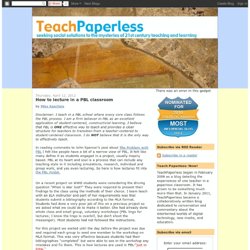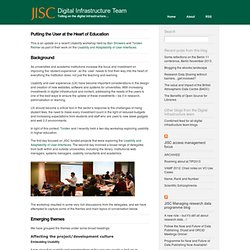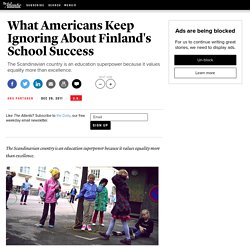

Konference Google apps. Patterns of Progress. How to lecture in a PBL classroom. By Mike Kaechele In reading comments to John Spencer's post about The Problem with PBL I felt like people have a bit of a narrow view of PBL.

It felt like many define it as students engaged in a project, usually inquiry based. PBL at its heart and soul is a process that can include any teaching style in it including simulations, research, individual and group work, and yes even lecturing. So here is how lectures fit into the PBL model. On a recent project on WWII students were considering the driving question "When is War Just? " For this project we waited until the day before the project was due and required each group to send one member to the workshop on MLA format.
Instead of forcing a lecture on students who are uninterested, PBL encourages students to struggle and get stuck first. Project-based learning. Learning Without Training. Successful businesses insure that software and tools are available for such things as bookmarking reference information, collaborating on tasks, searching organizational content, recording knowledge for peer learning, reinforcing of key concepts, locating experts, accessing outside information, and connecting with customers and partners.

Here are a few examples of learning before and after instituting the learning infrastructure we call a Workscape. Usually it’s training before and pull learning after, that is, from training to what Jane Hart has called learning without training. Revisiting Learning Styles. As part of David Kelly’s Learning Styles Awareness Day, I’m revisiting the idea of learning styles.

I admit that when I was taught learning styles in my education program, I didn’t question it. It made intuitive sense, and I’d never heard a real criticism of the theory. When I started digging into the research though, I realized that the research support for learning styles is pretty flimsy. If I think back to the way learning styles were taught to me though, it was never applied the way that the theory is “officially” supposed to work.
The most common idea is that people have some sort of style, and if you match that style they will learn better. That was never how it was applied in the classroom though. As a music teacher, that might mean something like teaching rhythms through multiple channels. If I was teaching music today, I’d do that same kind of lesson, just not because of learning styles. Judy’s idea of focusing on interaction preferences is an interesting one. Computer simulations in science education.
Unbundling education. Putting the User at the Heart of Education. This is an update on a recent Usability workshop held by Ben Showers and Torsten Reimer as part of their work on the Usability and Adaptability of User-Interfaces.

As universities and academic institutions increase the focus and investment on improving the ‘student experience’, so the ‘user’ needs to find their way into the heart of everything the institution does, not just the teaching and learning. Usability and user experience (UX) have become important considerations in the design and creation of new websites, software and systems for universities. Ten meta-trends impacting learning. In a world where libraries are completely reinventing themselves, where universities and schools are moving away from labs to BYOD, and where the focus of everything seems to be on mobiles —what will be the role of technology in the next decade?

What do leading institutions need to be doing now to prepare? What are the strategies that will provide them the most flexibility? The greatest competitive advantage? These are the overarching questions that recently drove the discussions at 10th anniversary New Media Consortium Horizon Project special convocation and retreat. Over its decade of work, the Horizon Project has grown to the point that it may very well be producing the single most important body of research into emerging technology within the world of education. The NMC and the Horizon Project are best known for its flagship Horizon Reports that focus on higher education and K-12 globally. Out of the discussion, 28 metatrends were identified. 1. The Problem of "Pedagogy" in a Web 2.0 Era. Pedagogy | Viewpoint The Problem of 'Pedagogy' in a Web 2.0 Era By Trent Batson06/15/11 In a time of knowledge stability, teach; in a time of rapid change in knowledge, learn… Clearly, we have left the time of knowledge stability and entered a time of incredibly rapid change.

IBSE. Importance of schools. Futuristic prognoses. Connectivism. Wolfram Education Portal: Free Resources and Materials for Teachers. Kirkpatrick's Revised Four Level Evaluation Model. I had an interesting discussion with Clark Quinn on using Kirkpatrick's model in learning processes other than courses.

Clark argues that use of Kirkpatrick’s model is only for courses because training is the dominant discussion on their web site. I disagree and wonder if perhaps it is more of a “not invented here” hesitation because advancing concepts to the next level has often been a primary means of moving forward. It might sound good to forget an old model, but if you do not help people relearn, then their old concepts have a nasty habit of reappearing. In addition, training is far more than just courses. So after some heavy reflection I did a rewrite on my Kirkpatrick web page and have listed some of the highlights below.
While some mistakenly assume the four levels are only for training processes, the model can be used for other learning processes. 1. Reaction is not a good measurement as studies have shown. 2. 3. In addition, it aids the troubling-shooting process. My eBooks. Content as curriculum? Zkoušení, do kterého se zapojí celá třída. Jak zapojit do ústního zkoušení na začátku hodiny celou třídu? Zvolila jsem následující způsob: (na SŠ je možné chtít třeba 5 otázek). Tato metoda má následující výhody: - žáci jsou nuceni , aby si mohli připravit otázky - , „přinejhorším“ může zopakovat otázky, které učitel položil v hodině. Ignoring What Works in Education. The Need for an Evidence-based Approach to Demonstrating Value.
When I read the Editor’s View column in the current issue of IWR (Information World Review, Nov/Dec 2011) the words seemed familiar.

Anarchy in learning - home. Students Reflect on Their Own Learning. We are always talking about the ideal education should be a learner-centered setting. What Americans Keep Ignoring About Finland's School Success - Anu Partanen - National. The Scandinavian country is an education superpower because it values equality more than excellence.

Sergey Ivanov/Flickr Everyone agrees the United States needs to improve its education system dramatically, but how? Nade Conference 2011; Stephen Downes: We don't need no educator (Part 1)